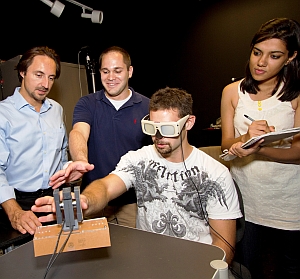
Marco Santello (left) and students in his lab conduct experiments in sensory and cognitive abilities. (Jessica Slater, Arizona State Univ.)
Grants from the National Science Foundation will fund research into sensory and cognitive connections between the brain and the hands that can lead to new prosthetic devices and treatments. The NSF funds totaling $640,000 will support research by Arizona State University biomedical engineering professor Marco Santello and Columbia University kinesiology professor Andrew Gordon.
Santello’s research investigates the neural control of the hand and the workings of senses such as vision and touch. Understanding the normal, easy functioning of the hand helps identify the impact of conditions that make those operations difficult, particularly the role of the brain in controlling those actions. In some of Santello’s experiments, for example, test subjects (pictured left) wear goggles to block their vision at selected times during the manipulation to interfere with the subjects’ abilities to learn and execute grasping tasks.
Gordon’s work involves the use of sensory information during the learning and control of manual skills, particularly the biological basis of hand impairments in populations — such as people with cerebral palsy — where movement disorders disrupt control of these sensory and motor functions. His collaborations with Santello focus on cognitive aspects of the interaction between the brain and the hands, assessing the information the brain gains and processes from sensing the shapes of objects and exploring the role of memory of past actions.
Santello and Gordon have collaborated for several years on research involving interactions between sensory feedback and motor actions to control the hand. In the past eight years, their research has broadened into the workings of physical motor skills by incorporating recent advances in knowledge of biomechanics, neurophysiology, and psychology.
Their new project aims to examine not only how objects are grasped, but the reasons people choose to grasp an object in the ways they do, to determine the neural mechanisms that control learning and planning of the grasping and manipulation of objects. The studies are expected to examine the visual cues people use to assess object properties before they grasp or otherwise manipulate objects. In using their hands, people often use cues such as object shape or density, as well as tap their memories of similar actions performed in the past.
The knowledge gained by this research can lead to improving neuro-prosthetics. Current technology, Santello notes, is able to provide extremely sophisticated artificial hands, but controlling the hands remains a challenge. “The more we understand about the high-level processing that the brain has to go through to plan an action,” says Santello, “the closer we will be to building more intelligent prosthetic systems that are capable of more human-like performance.”
Read more: Grant Awarded for Mind-Machine Engineering Research Center
* * *

 RSS - Posts
RSS - Posts
[…] Grants to Fund Brain-Hand Neural Connections Research […]